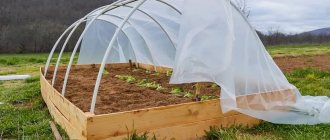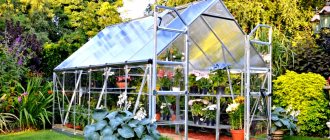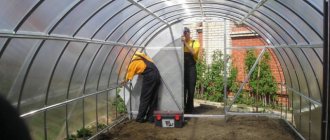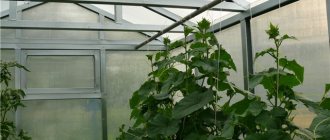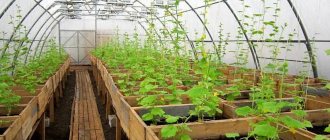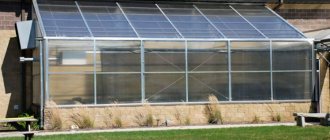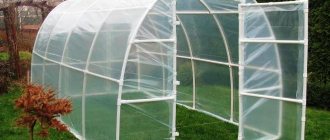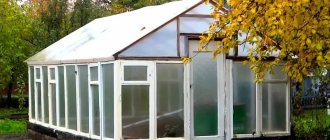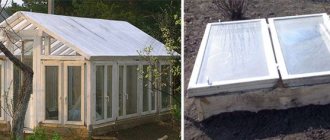In this article we will look at how to cover a greenhouse with film with your own hands, we will tell you what methods of attaching translucent material exist, what technologies help to quickly and correctly stretch the film onto the shelter frame. After reading the material, everyone will be able to calculate the amount of materials needed and choose the most suitable way to create a favorable microclimate for heat-loving plants.
A small greenhouse is covered with film Source stroy-podskazka.ru
Film, polycarbonate or glass: which is better?
Even at the initial stage, it is important to decide whether it is better to cover the greenhouse with a film or a covering material of a denser texture. The choice becomes much easier if priorities are set correctly. When the greenhouse is assembled in the spring for growing seedlings, you can get by with film. It is the cheapest covering material, which allows you to assemble a shelter in a couple of hours. One person can do the job.
In winter, the film is removed, the ground is exposed, covered with snow, and saturated with moisture. This has a beneficial effect on the ecosystem of the site. In closed greenhouses, in the absence of heating, the soil freezes to the deepest layer, causing the death of microorganisms, the activity of which improves the quality of the soil.
If you plan to use the greenhouse during frosts, you can cover it with polycarbonate sheets. This is a durable material, easily withstands wind and snow loads, and reliably protects plantings from weather influences.
Polycarbonate greenhouse in winter Source alyanssd.ru
It is chemically inert, so it is allowed to use the entire range of chemical fertilizers inside such a greenhouse. The special structure of the material provides high thermal insulation characteristics, but it transmits little light, so the inside of the greenhouse has to carefully consider artificial lighting and then increase the cost of paying for electricity.
In the hot season, there is a need to close the shelter from bright daylight. It greatly heats up the temperature inside the greenhouse, which has a bad effect on plant growth. Anyone who understands how to cover a polycarbonate greenhouse from the sun can easily cope with the problem of preserving the harvest. Typically, reflective film is used in such situations. It is laid directly on top of the building frame.
When the question is what to cover a greenhouse with other than polycarbonate, glass is usually chosen. This is the most expensive way to organize the cultivation of plants during the cold period, but the most effective. Usually it is used mainly for organizing year-round cultivation of plants.
Greenhouse covered with glass Source zimsad-master.ru
Its choice is considered inappropriate from an economic point of view if the greenhouse “operates” periodically, from time to time. In situations where the shelter is used from May to October, it is better to cover it with film. This design has its own characteristics, understanding them allows you to extract maximum benefit.
How to quickly build a greenhouse with arcs (with photo explanations)
As a rule, the first greenhouse in a country house or garden is made from inexpensive materials: you need to try what it is and evaluate how profitable the idea is. Hence the requirements: a simple, prefabricated structure made of inexpensive, accessible materials. These requirements are fully met by frame greenhouses with arcs made of PVC pipes (HDPE can also be used).
This greenhouse on arcs made of PVC pipes is assembled by one person in 3-4 hours.
Materials and tools
A greenhouse like the one in the photo above can be made in a few hours. You will need the following material:
- Board for the base, size at least 75*40 mm, length depends on the dimensions of your greenhouse. A frame is made from timber, which lies around the perimeter of the greenhouse. If the greenhouse is 6*3 meters, then 18 meters of timber are needed, if 8*3 m, then 24 meters, etc.
- Board with a section of 50*20 mm for organizing the front door.
- PVC pipes with a wall thickness of at least 2 mm. The length depends on the dimensions of the greenhouse. If you are going to build a greenhouse, then at the top point its height should be at least 2.2 meters. Then you can work inside without any difficulty.
- Reinforcement with a diameter of 14-16 mm. It should be slightly smaller than the internal diameter of the PVC pipes.
- Covering material - film or agrofibre. Others will not be suitable for this design.
- Perforated metal strip.
- Wood screws.
Before using wood, treat it with anti-rot and insect repellents. If there are pieces of bark somewhere, you need to get rid of them. This is where most of the larvae are. If there are any factory impregnations, you can use them. If not, used machine oil will do. If this is not there, you can burn the wood with a blowtorch. This method is unreliable, but even such processing is better than no processing.
stroychik.ru
Device principle
The protective shelter, which is created using a frame and film, is used only for growing seeds and seedlings of garden crops. It absorbs the sun's rays and converts them into thermal energy. Inside the greenhouse it is always several degrees warmer than outside, even without additional heating. Its installation helps to create a microclimate favorable for the growth of garden crops. The shelter reliably protects crops from precipitation, strong winds, and prevents the penetration of insects that can harm seedlings or adult plants.
In order for the greenhouse to work efficiently, during its installation it is necessary to correctly calculate the amount of covering material. To do this, you need to make calculations and take correct measurements. It is easier to solve the problems when the length of the frame and the width of the covering material are known.
The calculation requires the length of the greenhouse and the width of the film Source greentalk.ru
See also: Catalog of country house projects
If the structure of the greenhouse is arched, the length of the canvas should be equal to the length of the arc. When the greenhouse has a frame with a “pitched roof”, the film is calculated taking into account the height of the walls and the length of the slopes. The resulting figure should be equal to the length of the film. To find out how many of these pieces are needed to completely cover the shelter, you need to divide the length of the greenhouse by the width of the film. Since individual pieces are then overlapped, it is important to add 25 cm to the width of each piece (for allowances).
In order for the greenhouse coating to ensure the performance of its functions, it is important to pay attention to the following nuances:
- It is better to cut the covering material on site. It will be much easier to do this if you lay the roll next to the frame in width, and then throw it across the structure, stretch it well on both sides, add 25 cm to the right and left for allowances, and only then cut off the first piece.
- The second strip is cut in the same way. It is laid over the first one with an overlap (25 cm) and secured with construction tape.
- As many pieces are cut as needed to cover the greenhouse from start to finish.
- The ends are cut in the same way and also with allowances of 25 cm.
- Doors and windows are cut out after installing and attaching the film.
Film strips are laid overlapping Source 9dach.ru
Note! It is better to cut the film in calm weather; if the covering material sways and bends under gusts of wind, it will not be possible to stretch it properly.
Knowing how to cover a greenhouse with film, it is not difficult to calculate the amount of covering material. But when buying it, it is important to look at the form in which it is sold. Polyethylene film has a standard width. It is equal to 150 cm. But some manufacturers sell rolls in the form of a sleeve. Before covering the greenhouse, it will have to be cut along one edge of the bend and unfolded.
See also: Catalog of companies that specialize in the installation of metal structures
How to cover a greenhouse - choosing the best material
Greenhouse owners know that a special film was once sold - no drops hung on it, but immediately flowed down an inclined slope. But then such production was stopped, allegedly due to the high cost of raw materials, to which special minerals were added. Therefore, today you won’t find real winter greenhouses and greenhouses under film – all because of the humidity.
After all, in cold weather you will not open the door to the street - and therefore all the drops, due to the cheap properties of modern material, will be over your head. In spring and summer there are no such problems, of course. Therefore, if the greenhouse under the film was made in order to grow in it all year round, then install a gas boiler, it increases CO2 and combats excess humidity well.
The so-called heavy-duty greenhouse film is also sold on the market. Also, not many people know about high-quality Italian film of 200 microns - it is folded 4 times. Just how to cover a greenhouse with such a film is another question - those who have already practiced this claim that sometimes it is necessary to involve up to 10 people!
Characteristics of different films
When deciding how to cover a greenhouse, it is important to determine what functions it will perform: in winter, to protect plantings from frost, or in warmer times of the year, to help seedlings ripen faster and bear fruit. Clearly defined goals help you choose the right coating material.
Polyethylene film is suitable for covering greenhouses used in the warm season. It is removed for the winter, the frame is disassembled and reinstalled in the spring. For such events, roll material with a thickness of 150-200 microns is most suitable.
Marking of polyethylene film Source fishing-caravan.ru
Reinforced film is ideal for those who want to install a greenhouse once and then use it for three years without disassembling or removing the shelter for the winter. The density of this material is 150–200 g/m².
PVC film is a good choice for winter greenhouses. They help grow plants even at -15 degrees below zero. During the day, the material does not let the sun's rays through; at night, the film retains heat well.
Frost-resistant film is used to create industrial greenhouses. It can last more than seven years and does not stretch during its entire service life. Easily withstands hail and is not damaged.
Amateur gardeners, studying the offered assortment, often wonder what is the best way to cover a greenhouse. Experts advise using the first three types of film. They are inexpensive and can be used to quickly cover a greenhouse for growing a small volume of garden crops.
Film fastening elements
When cutting the film, its initial fastening is done using tape. You cannot leave the greenhouse like this: the first strong gust of wind will tear the covering. The correct choice of fastening type will help prevent this. It depends on what type of frame is used to create the shelter.
Clamps for film on a greenhouse Source semopt.ru
Paper clips
A very budget option that does not require additional steps from you to make the mount.
To ensure that the paper clips hold well, choose the largest ones. Such binders are sold in any office supply store.
In bad weather or strong winds, the coating may be damaged by the metal part of the fastener. To prevent this, place fabric or rubber under each binder.
Rail fastening
Not everyone knows how to attach film to greenhouse arches made of wood. The method of fixing rolled material is actually extremely simple:
- small wooden blocks 10 cm long are cut;
- processed with sandpaper;
- then wrapped in several layers of polyethylene film;
- the first layer, the one that will come into contact with the frame of the greenhouse, is coated with rubber glue;
- The block is applied to the fastening point, and then fixed with a self-tapping screw for reliability.
Attaching the film to a wooden frame with slats Source fishing-caravan.ru
The presence of glue under the attachment point ensures a tight connection, which extends the service life of the shelter. When wooden slats are not available, pieces of old linoleum or plastic tape, which is used for packing boxes, can replace them. It is attached to the wooden frame using a construction stapler.
If you need to decide how to attach the film to a metal greenhouse frame made from a profile, you should use the following advice. It is better to fix the covering material with wooden blocks, but they should be fastened with self-tapping screws not to the frame arc itself, but to the ends of the greenhouse, to its metal posts. When the frame of the greenhouse is assembled from reinforcement rods, the easiest way is to attach the film to it with office clothespins (these are used to fasten sheets in a folder).
We are building a budget version of the “film” design
Two layers of film will withstand short-term frost without problems - but if you heat the greenhouse, this is not a problem at all.
And here’s how greenhouses are covered with three layers of film (which is especially important for the northern regions): the second layer is inside the frame, and between the two layers there remains from 7 to 10 cm. But with the third you will have to tinker: nail the crossbars onto the internal racks so that the height in the center it turned out to be about 2 m, and on the sides - 1 m 20 cm.
There should be 3 meters between the crossbars, and take a film of the same width. Nail it down with strips of conveyor belt. So inside the greenhouse, it’s as if there’s another one, and between the films themselves there are two whole air layers. Summer residents call such structures “thermos” - they are so warm and comfortable for plants. But in the spring you can safely remove the third layer - it is not needed yet.
Mesh fastening
Some gardeners use another simple method of attaching rolled material. They cut the film, connect the individual parts together with double-sided tape, stretch the covering material onto the greenhouse, fix it at the bottom with clips or bars, and lay a coarse mesh over the top area. It is attached to the frame of the greenhouse using wire. This method has its pros and cons. The practice of using such structures shows that they cannot withstand strong winds. Every time after another bad weather, the greenhouse has to be re-tightened.
Fastening with rope and harness
Buying a mesh increases the cost of installing a greenhouse; if you want to save money, you can try fixing the film with a polypropylene cord or an elastic band. They are first fixed with a knot on the lower part of the first arc of the frame, and then thrown over it, stretched and fixed on the opposite side of the frame. Then they are thrown again and fixed on the next arc of the base. The film is attached in this way, in a zigzag manner.
Fastening with eyelets
It can be used if a very dense film is used to cover the greenhouse. It is first cut into strips. Holes (openings) are made along the edges on one and the other side of the future canopy. They are then reinforced with a plastic or metal ring. A cord is threaded through it, with the help of which the film is attached to the frame of the greenhouse.
Film with a metal eyelet Source klen.by
The strips are connected to each other by soldering. To carry it out, an iron, blowtorch or alcohol lamp is used. First, the strip fragments are folded together, then they are covered with old newspapers, and only after that they are ironed or processed with a soldering iron. During this procedure, it is important to observe the temperature regime; you cannot hold the selected instrument over the coating material for a long time.
Technologies do not stand still; today materials are appearing on sale that make it possible to improve the design of shelters for plants and reduce their cost.
Features of covering a greenhouse with a film of two layers
Many of those who want to make their greenhouse more durable and suitable for use in cold weather use two layers of film. To do this, the film sleeve is not cut, but a strong cord is threaded along its edges, which secures the strip on each side of the greenhouse to the frame. With this method, each strip is fastened separately. The overlap should be 15 cm. Covering a greenhouse with film is quite a troublesome task, but if you do everything according to the rules and slowly, the structure you make will last a long time.
Briefly about the main thing
By understanding how and what to cover a greenhouse with, you can create shelters that can last in the garden for several years. Experts advise cutting it out right away and keeping a spare case on hand. It will help, in case of damage to the film, to replace it in time and prevent the death of plants. The method of fastening the covering material is selected taking into account what the frame is made of.
A little more attention!
What do you think - which method of attaching film to a greenhouse is more reliable? Maybe it is better to use polycarbonate or glass to cover the greenhouse?
Double sided tape
This method was invented a long time ago, even before the release of plastic clamps. It is not very convenient, but is still used by some summer residents. Scotch tape is usually short-lived, although it is also cheap and available. To secure the film with it, you must first degrease the surface of the frame where the tape will adhere.
Postures for heart health: how to sit correctly
An old stepladder, potted flowers and an armchair: how to turn a balcony into a cozy place
How to make a comfortable hammock for a cat using improvised materials: he will be delighted
Then tape is glued to the metal frame, the protective film is removed, and a film is placed on top. It is necessary to pass something even and heavy over the gluing area, then the air bubbles will be removed. This is rather a temporary method; when moisture gets in, the tape quickly loses its properties. It will also not be possible to achieve complete tightness of the connection; there will be gaps through which cool air will enter.
